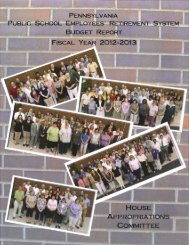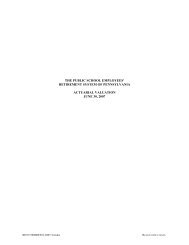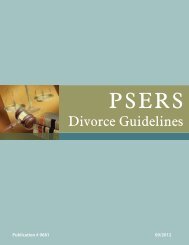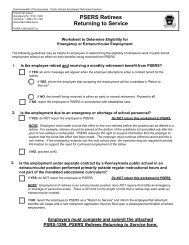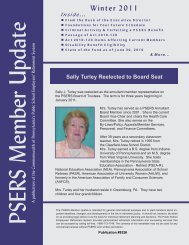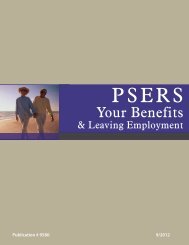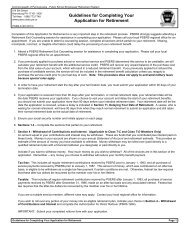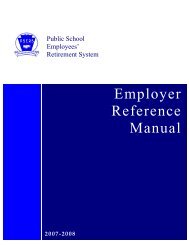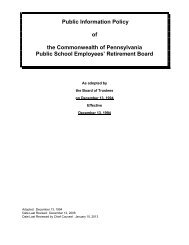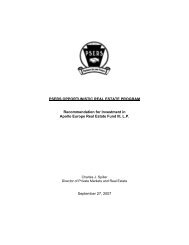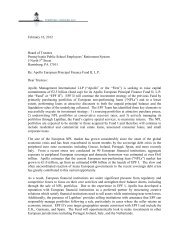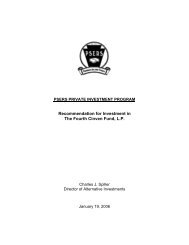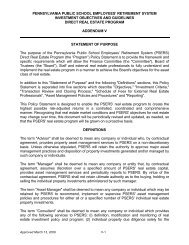a complete copy of the 2012 CAFR Report! - PSERs
a complete copy of the 2012 CAFR Report! - PSERs
a complete copy of the 2012 CAFR Report! - PSERs
You also want an ePaper? Increase the reach of your titles
YUMPU automatically turns print PDFs into web optimized ePapers that Google loves.
Management’s Discussion and Analysis (continued)<br />
FINANCIAL SECTION<br />
History <strong>of</strong> PSERS' Contribution Rates as a Percent <strong>of</strong> Payroll<br />
21<br />
Average Member Rate Employer Contribution Rate Employer Normal Cost Rate<br />
18<br />
15<br />
Percent<br />
12<br />
9<br />
6<br />
3<br />
0<br />
1983 1988 1993 1998 2003 2008<br />
Year<br />
<strong>2012</strong><br />
Pennsylvania Act 120 <strong>of</strong> 2010<br />
On November 23, 2010, <strong>the</strong> Governor signed HB 2497 into<br />
law. The legislation is now known as Act 120 <strong>of</strong> 2010.<br />
Act 120 preserves <strong>the</strong> benefits <strong>of</strong> existing members and includes<br />
a series <strong>of</strong> actuarial and funding changes to PSERS<br />
and benefit reductions for individuals who become new<br />
members <strong>of</strong> PSERS on or after July 1, 2011. The Act created<br />
two new membership classes, T-E and T-F.<br />
Act 120 has a projected net savings <strong>of</strong> $1.38 billion thru FY<br />
2044 as <strong>the</strong> $24.65 billion <strong>of</strong> projected savings from benefit<br />
reductions is <strong>of</strong>fset by <strong>the</strong> $23.27 billion cost <strong>of</strong> deferring<br />
contributions for budgetary purposes. Act 120 addressed<br />
<strong>the</strong> pending employer contribution rates spike projected for<br />
FY 2013 by smoothing <strong>the</strong> projected rate increases over a<br />
five to nine year time period. In addition, <strong>the</strong> benefit reductions<br />
and risk sharing provisions for new members on July<br />
1, 2011 and <strong>the</strong>reafter have created a low employer cost<br />
structure for new members and shifted some <strong>of</strong> <strong>the</strong> investment<br />
risk to members. The employer normal cost for Act<br />
120 members is 68% less than pre-Act 120 members as <strong>the</strong><br />
benefit plan is primarily member funded.<br />
Benefit Changes<br />
All new members will automatically become Class T-E<br />
members. New members however, will have a one-time<br />
opportunity to elect Class T-F within 45 days <strong>of</strong> receiving<br />
written notification from PSERS. Failure to elect Class<br />
T-F at time <strong>of</strong> original eligibility will make <strong>the</strong> member<br />
ineligible for Class T-F forever. In o<strong>the</strong>r words, once <strong>the</strong><br />
election is made ei<strong>the</strong>r by action or inaction, <strong>the</strong> election<br />
is permanent. Provisions affecting both new membership<br />
classes are as follows:<br />
• The cost to purchase Non Qualifying Part Time<br />
(NQPT) service and most types <strong>of</strong> nonschool or<br />
nonstate service credit (o<strong>the</strong>r than military service)<br />
will be <strong>the</strong> full actuarial cost <strong>of</strong> <strong>the</strong> service.<br />
• Ten year vesting period.<br />
• For normal retirement, employees must work until<br />
age 65 with a minimum <strong>of</strong> 3 years <strong>of</strong> service, or<br />
attain a total combination <strong>of</strong> age and service that is<br />
equal to or greater than 92 with a minimum <strong>of</strong> 35<br />
years <strong>of</strong> service.<br />
• No projection <strong>of</strong> service for determining normal<br />
retirement.<br />
PAGE 31



